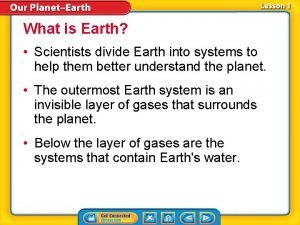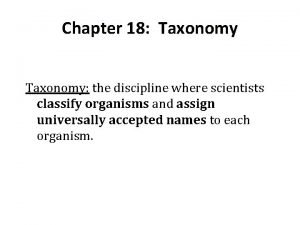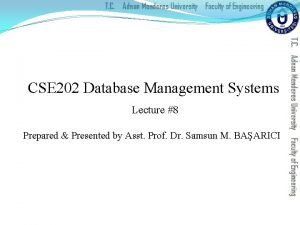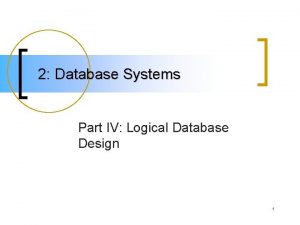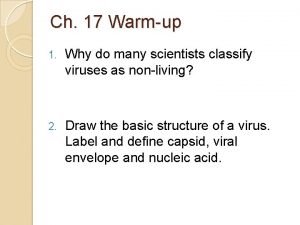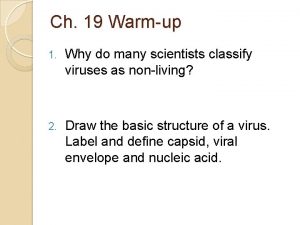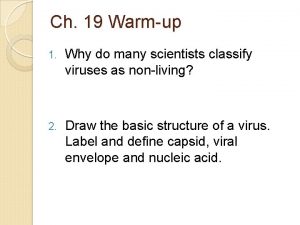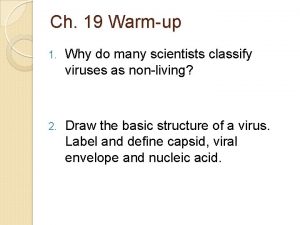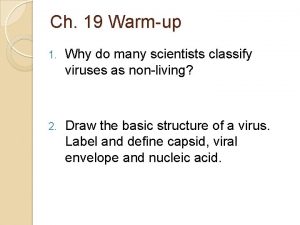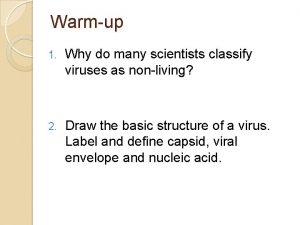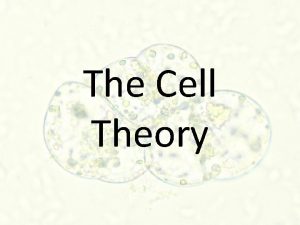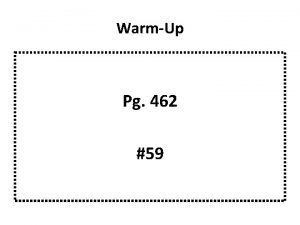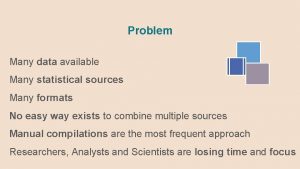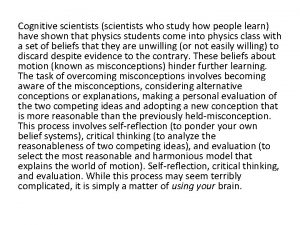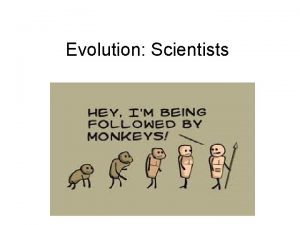Ch 19 Warmup 1 Why do many scientists































- Slides: 31

Ch. 19 Warm-up 1. Why do many scientists classify viruses as non-living? 2. Draw the basic structure of a virus. Label and define capsid, viral envelope and nucleic acid.

Ch. 19 Warm-up 1. Draw the lytic/lysogenic cycle. 2. What stage of the lytic-lysogenic cycle is a virus virulent? Temperate? 3. What determines a host range?

Viruses Chapter 19

What you must know: The components of a virus. The differences between lytic and lysogenic cycles.

Bacteria vs. Viruses Bacteria Prokaryotic cell Most are free-living (some parasitic) Relatively large size Antibiotics used to kill bacteria Virus Not a living cell (genes packaged in protein shell) Intracellular parasite 1/1000 size of bacteria Vaccines used to prevent viral infection Antiviral treatment

Viruses Very small (<ribosomes) Components = nucleic acid + capsid ◦ Nucleic acid: DNA or RNA (double or single-stranded) ◦ Capsid: protein shell ◦ Some viruses also have viral envelopes that surround capsid Limited host range (eg. human cold virus infects upper respiratory tract) Reproduce within host cells




Simplified viral replicative cycle

Bacteriophage Virus that infects bacterial cells

VIDEO: T 4 PHAGE INFECTION

Lytic Cycle of T 4 Phage

Bacteriophage Reproduction Lytic Cycle: ◦ Use host machinery to make copies of virus ◦ Death of host cell by rupturing it (lysis) lysis ◦ Virulent phages replicate by this method Lysogenic Cycle: ◦ Phage DNA incorporated into host DNA and replicated along with it ◦ Phage DNA = prophage Temperate Phage: uses both methods of replication

Lytic Cycle vs. Lysogenic Cycle

Animal viruses have a membranous envelope Host membrane forms around exiting virus Difficult for host immune system to detect virus

VIDEO: HOW DENGUE VIRUS ENTERS A CELL

Retrovirus RNA virus that uses reverse transcriptase (RNA DNA) Newly made viral DNA inserted into chromosome of host Host transcribes viral DNA (= provirus) provirus to make new virus parts Example: HIV (Human Immunodeficiency Virus)

HIV = Retrovirus

HIV ◦ Infects white blood cells ◦ HIV+: provirus (DNA inserted) ◦ AIDS: active viral reproduction

VIDEO: HIV LIFE CYCLE

Other Human Viruses Herpes virus Smallpox Herpes Simplex Virus 1 (HSV-1) Herpes Simplex Virus 2 (HSV-2) Eradicated in 1979 due to worldwide vaccination campaigns

Ebola Transmission: Transmission contact with contaminated blood or bodily fluids Symptoms: Symptoms fatigue, fever, severe headache, vomiting, diarrhea, rash, bleeding ◦ May appear 2 -21 days after exposure

Ebola Treatment: Treatment ◦ Intravenous fluids, balance electrolytes ◦ Experimental: antiviral drugs, plasma transfusions from survivors, antibodies (Zmapp) ◦ No vaccine (yet) Statistics: Statistics ◦ 2014 Ebola Outbreak (worldwide): 21, 382 cases, 8474 deaths (*as of 1/19/15) ◦ Seasonal Influenza: estimated 36, 000 deaths in U. S. each year (2015: mutated H 3 N 2 strain)

2014 Ebola Outbreak

Cumulative Ebola Cases

Vaccines Weakened virus or part of pathogen that triggers immune system response

Emerging viruses = mutation of existing viruses

Viroids Small, circular RNA molecules that infect plants Cause errors in regulatory systems that control plant growth Eg. coconut palms in Philippines

Prions Misfolded, infectious proteins that cause misfolding of normal proteins Eg. mad cow disease (BSE), Creutzfeldt. Jakob disease (humans), scrapie (sheep)

Diseases caused by prions Prions act slowly – incubation period of at least 10 years before symptoms develop Prions are virtually indestructible (cannot be denatured by heating) No known cure for prion diseases
 Pictures
Pictures Scientists divide the atmosphere into how many layers?
Scientists divide the atmosphere into how many layers? Warmup ratio
Warmup ratio Warmup 65
Warmup 65 Gmass warmup
Gmass warmup Stratified warmup
Stratified warmup Surface area warm up
Surface area warm up Mind rhyming words
Mind rhyming words Properties warmup
Properties warmup Java warmup
Java warmup Define:warmup
Define:warmup Ethos warmup
Ethos warmup Tinman schwartz
Tinman schwartz Warmup 65
Warmup 65 Warmup end
Warmup end Why do scientists classify organisms?
Why do scientists classify organisms? What is significant figures
What is significant figures Why do scientists classify things
Why do scientists classify things 1st layer of atmosphere
1st layer of atmosphere Dont ask
Dont ask Many sellers many buyers
Many sellers many buyers E r diagram
E r diagram Bookstore database design
Bookstore database design Are the glue that holds the entities in the erd
Are the glue that holds the entities in the erd Unary many to many
Unary many to many Erd film
Erd film Unary many to many
Unary many to many Many to many communication
Many to many communication Sqlbi many to many
Sqlbi many to many Example of unary relationship
Example of unary relationship Many sellers and many buyers
Many sellers and many buyers Scientists recently discovered that rocks collected
Scientists recently discovered that rocks collected

